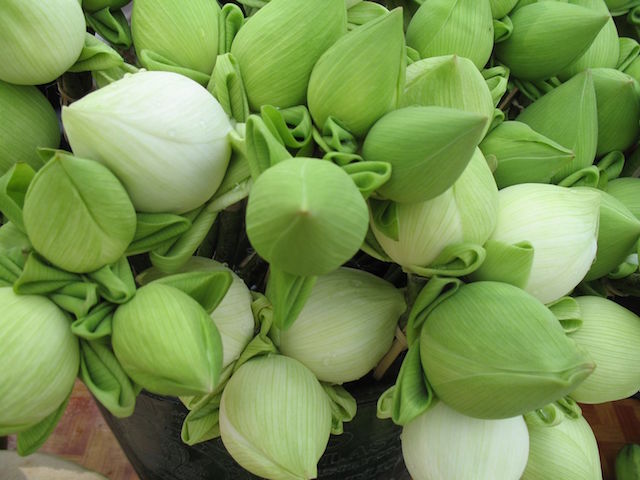By Biba Vilayleck
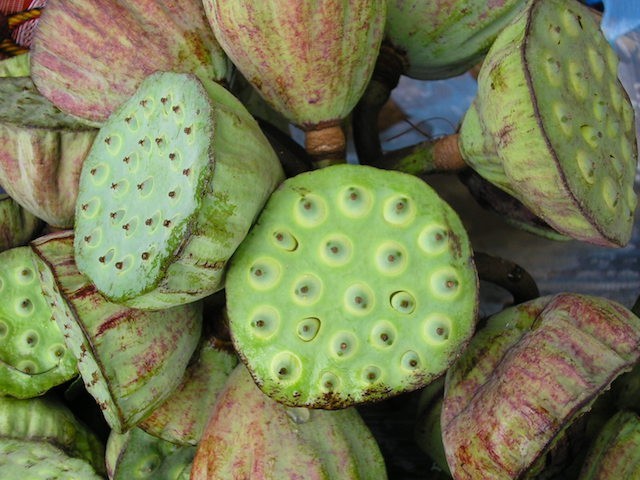
“Like the lotus which attaches itself to neither the water nor the mud, the wise man attaches himself neither to sensual pleasures nor to the world”. -Suttanipatta
The lotus is a very good example of the way that man de-pends on Nature not only for his sustenance but also for elements of his dreams, aspirations and beliefs. Man invents nothing, his imagination is restricted to his environment but his genius is to use it to survive and to dream. A sacred plant in Egypt and in Japan, the lotus is also profane, an everyday plant a plant one can eat, drink and use to care for oneself. Its importance is such that one cannot give it a quick glance or a summary. We speak of Laos knowing that in all the indo-Malaysian zone, this complex plant is at the same time a food, a medicine, a flower of dreams and of the law.
The Words to Say It
The name lotus as used by Buddhist texts belongs to two different genera of the botanical family nymphaeceae : the Indian lotus, Nelumbo nucifera, originally from equatorial Asia, (but arriving in Egypt about the time of the Persian con- quest), and the Egyptian lotus, Nymphaea lotus, nenuphar, which has spread all over the world. Their name indicates their geographical situation. Nelumbo is one of the names of the flower in Sri Lanka. Nymphea comes from the Greek and nenuphar from Arabic and from the Persian (nanophars ‘the beautiful’) As for the name lotus, it is of uncertain origin in ancient Greece it meant several plants of which one ate the seeds. In Laos, one differentiates between two flowers called boua. But the Indian Lotus or sacred lotus is sometimes called boualouang (royal lotus) and the nenuphar is called bouanyou bouangeun, (small lotus or silver lotus).
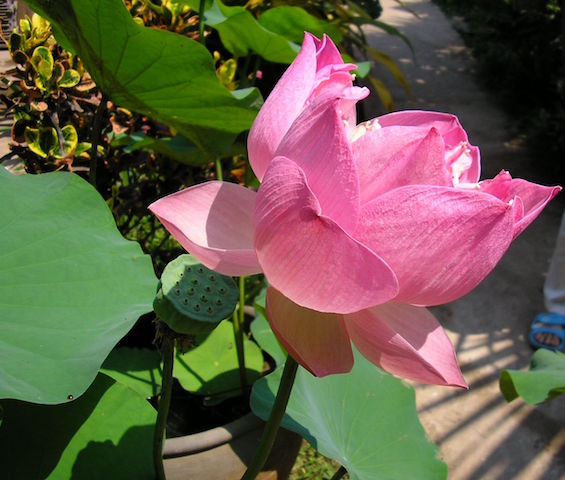
Botany
The two plants are perennial aquatic herbs whose rhizomes are attached to the bottom of lakes and ponds. The leaves of the nenuphar lie on the surface, they are flat with regular notches, rounded and split. Those of the lotus rise up out of the water at the end of a rather complex process of devel- opment. “The first tiny leaves remain in the water; the sec- ond, more important leaves, float on the surface and then, as full-blown leaves, grow higher until the size of the petiole, bristling with plumes… after this the small, thin, dark green leaf with a bare petiole appears, this is the final leaf and it is then that the rhizome is harvested.” (Metailie)
In the same way, the flowers of the nenuphar lie on the surface of the water while the lotus flowers rise above the surface. As a general rule the flower of the lotus is bigger than that of the nenuphar, its petals are larger and rounded while those of the nenuphar are more pointed and narrow, attached in a spiral. At the centre of the lotus flower, a large fruit develops in the shape of a closed cone which contains the hard seeds, like nuts, whose germinating power can last for centuries. The fruit of the nenuphar ripens under the water. Lotus flowers are white or pink while nenuphars are white, pink, yellow or blue.
Lotus or nenuphar, this beautiful and complex flower, which takes root in still water, carries a rich and powerful symbolism everywhere it grows.
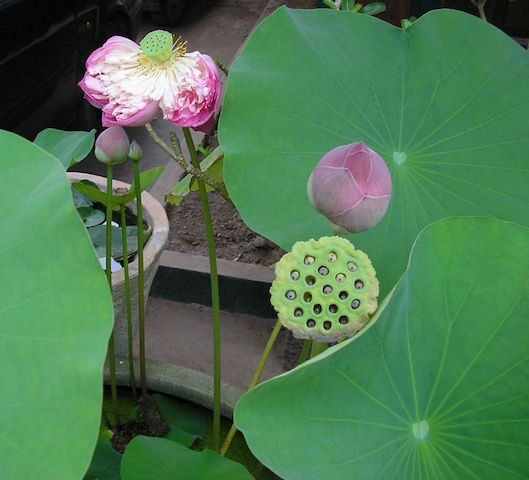
The Symbol
The lotus seems to have first been considered as a symbol of fertility. It is life, fecundity, because it is rooted in the water and grows towards the sun. As well, the way the seed ripens in the fruit suggests analogies with human reproduction. In Egyptian iconography, the sun bursts from the open blossom. It is the archetypal vulva.
In Hinduism as in Buddhism, the lotus is associated with the birth of divine beings. Brahma was born by a lotus issuing from the navel of Vishnu sleeping on the primordial waters. Lakshmi, goddess of fertility gave her name to the lotus. She is sometimes confused with Mahamaya, the mother of Buddha, because the lotus was adopted by Buddhists as the symbol of the conception and birth of the sage, conceived when a white elephant touched the queen, his mother, with a white lotus.
This symbolism is also found at a linguistic level in several languages – in China it is used specifically for the vulva and a courtesan is called golden lotus. In Cambodia in the language of magic, lotus flower means a fetus. In Laos, on the other hand, the bud of the flower that opens and closes is compared to a phallus. (Archaimbault)
In India, flowers in general and the lotus in particular are symbols of the spiritual accomplishment of a being, because of the obscurity associated with deeper water up to the flowering in the full light of the upper water. Thus the lotus represents the stages of spiritual progress. During meditation in the lotus position, cosmic energy rises along subtle centres of the body named chakras (wheels) or padma (lotus) to reach the top of the head and enlightenment. The basic points of this spiritual journey are represented by lotuses with different numbers of petals.
The lotus is equally a climatic symbol, the numerous petals suggesting the cyclical nature of theof seasons and, further that the seedpod, the open flower and the bud represent the past, present and future. In Buddhism, the lotus represents purity because its flower rises above the vase like the Enlightened One above the world.

“Like the lotus which attaches itself to neither the water nor the mud, the wise man attaches himself neither to sensual pleasures nor to the world.”
-Suttanipatta
Actually, the metaphor expands to be that the lotus is the Buddha. In the original iconography the lotus was only the representation of Enlightenment; later it came to be the throne and to be an enduring element of Buddhist architecture and religious decoration. The lotus is more than a flower, it is evidence of the divine.
Religion
Carrying such powerful symbolism, the lotus has a very special place in the Buddhist religion as it is reserved exclusively to pay homage to the Enlightened One. In Laos it is not arranged like other flowers in various complicated ways and the style that ranges a number of petals around the base of the bud is considered heretical by the old people because the offered flower should not be transformed or even smelled. The Lotus is never used in the flower arrangements for the ceremonial soukhouane (baci) trays nor in the maakbeng. It is placed on the altar dedicated to Buddha in the temple or in the home. It is also sometimes held by a young man who is on his way to being ordained. It is offered as it is picked, a plain bud at the end of a long stem with no leaves. It is closer to being a symbol than a flower, an abstraction which shows its mystical potential. Other flowers that are treated as objects do not have the same presence as the lotus— more than a flower, the lotus is a cosmic symbol. As such it leads one along the path to Enlightenment: the Saddharma-pundarika-sutra, the “Lotus Sutra”, and “Lotus of the Law of Goodness” are canonical texts containing the fundamental teachings of Buddhism and the numerous ways to reach Enlightenment. It should be noted that the water jars containing lotus flowers that one sees more and more in front of houses in Laos, have nothing to do with religion, but are a Chinese tradition in which water is necessary at the front of the house to ward off evil spirits who try to enter the house.
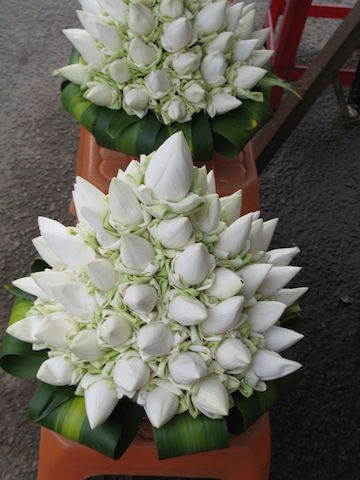
Art
In the continuity of the religion, the lotus is a fundamental element of religious art that can be seen in Laos and in neighboring countries. Figurative or stylized, it is omnipresent in architecture and statuary, in frescoes and bas-reliefs, in decorative motifs. In temples as monumental as That Luang or more modest, there are statues of Buddha reclining on an open lotus. As a bud, the lotus rhythmically outlines the buildings, the staircases, the angles at the corners. The life of the Buddha is told along the walls of the temples, it plays out in a legendary world in the midst of imaginary nature where only the tree of knowledge, (Ficus religiosa) and the lotus are to be found. Stylised, metamor- phosed into vines and ferns, the flower runs along columns, on the portals and windows of the temples. Even religious objects themselves seem to follow the form of a lotus, that of the bud both closed and open: the bay sema, the stone which marks the sacred space, the monks’ prayer screen, and the maak beng, the conical floral arrangement. If in Laos, art is basically religious, it is not the same in China, for example, where the representation of flowers is done according to precise aesthetic criteria and that of the lotus is among the most beautiful of these.
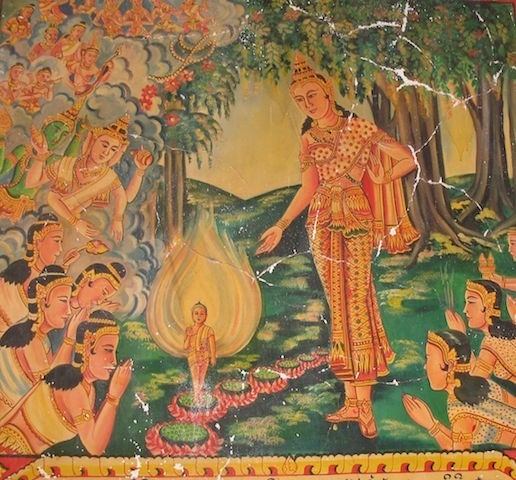
Gastronomic Uses
Nonetheless, the lotus, which one would think would be reserved for religion, has a number of nonreligious uses as well as the Chinese saying goes. “With a lotus pond at one’s house, no worry in the bad years.”, because this plant is also a legume. The rhizome of the Indian lotus (hack boua) can be eaten raw, but it is very bland and is usually made into a sour salad (tam som). Boiled, it is dipped in a sauce as an appetizer, after cooking in sugar it makes a refreshing black drink (nam houa boua) which is sold by street vendors, and in China a starch is extracted to make a New Years cake. The stems of the nenuphar (sayboua) are used in stir-fries and soups; cut into slices and dried in the sun they are a dried legume. The seeds are mainly used as food. In Laos they are eaten raw after they have been peeled but our neighbors in Vietnam make candy with them, and the Chinese boil and roast them. Many teas of the region are flavoured with lotus petals or stamens. And lastly, the large leaves of the lotus are used sometimes to wrap food, in particular for certain cakes of sticky rice, which take on the flavor of the leaves.

Medicinal Uses
In traditional medicine, the lotus is considered a calmative plant, but the origin of its name is perhaps not unfamiliar in this usage. In fact, in the Odyssey, Ulysses meets the Lotus Eaters who make a forgetfulness potion and the name lotus remains associated with sweet dreams. Again today, when we buy lotus seeds, the shopkeeper will say that you will havea good sleep. The seeds also have a tonic and revitalizing effect. Nevertheless, the botanist Petelot who visited Indochina in the 1930”s made note of some surprising uses: “The seeds are fortifying, a sovereign remedy for dysentery, nocturnal emissions, erotic dreams, …. they diminish the frequency of erections, but increase the quality of the sperm…. the fruit in a decoction is known to help and lessen urinary emissions.”
In Modern Times
If we go back to the sacred texts we find the following passage from the Bhagavad Gita:
“Whoever dedicates his efforts to the Supreme Being by removing all self interest is not touched by sin just as the lotus leaf is not affected by water.”
Men of that era had already noticed these water-repellent properties, now being studied by researchers for possible industrial applications, particularly in aeronautics. The lotus is also popular plant in the west because of a fascination for the Orient and its symbols, in decoration (spas) foods, (tea) and even cosmetics, with one brand offering a ‘nirvana se- rum !’ And we cannot forget the song ‘Oh, Dok boua thong’ (Oh, golden lotus). This melody, dear to the hearts of Lao people, brings us to a close.
The words are not entirely clear, but Kham On Keopraseuth observes “The metaphor of the existential path leading through solitude of the world to attain the supreme consciousness….’’
When I pick you and smell your fragrance
I will love you with all my soul
I will put you into a cup of gold
I will never let you wilt nor wither.




